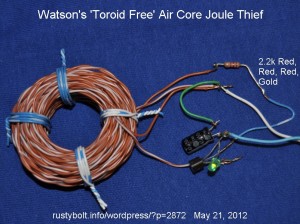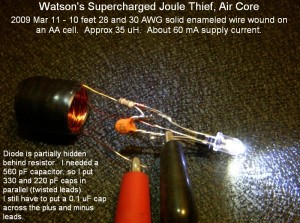 We don’t need no stinkin’ toroids! Just wind 15 to 20 feet of twisted pair (this wire was from cat5e cable) onto something round, like a C or AA cell. Then slide it off and tie it up in 3 or 4 places with some thread, twine, dental floss, piece of wire, or tape. The inductance is under 100 microhenrys but it works okay.
We don’t need no stinkin’ toroids! Just wind 15 to 20 feet of twisted pair (this wire was from cat5e cable) onto something round, like a C or AA cell. Then slide it off and tie it up in 3 or 4 places with some thread, twine, dental floss, piece of wire, or tape. The inductance is under 100 microhenrys but it works okay.
The typical cat5e cable uses 23 AWG solid conductor wire, which has about 20 milliohms per foot. Fifteen feet adds up to about 300 milliohms, or a little less than a third of an ohm. That’s not too high for a JT, but I prefer to keep it to less than 1/4 ohm. Lower resistance means less losses and higher efficiency.
 This is a picture of a Supercharged Joule Thief taken in March, 2009. It also uses an air core coil. With the lower inductance, the SJT can run at much higher frequencies, close to or in the AM broadcast band. It’s a good idea to check to make sure your SJT isn’t broadcasting in the AM band.
This is a picture of a Supercharged Joule Thief taken in March, 2009. It also uses an air core coil. With the lower inductance, the SJT can run at much higher frequencies, close to or in the AM broadcast band. It’s a good idea to check to make sure your SJT isn’t broadcasting in the AM band.
Back to experimenting…











